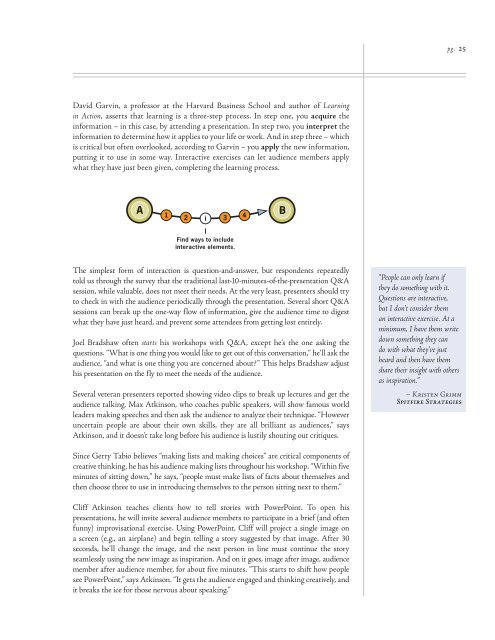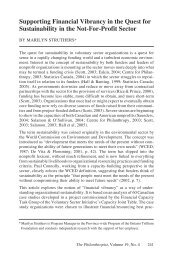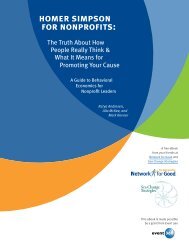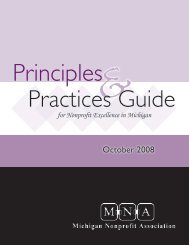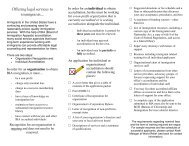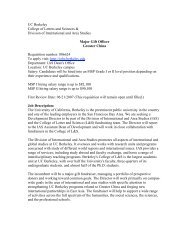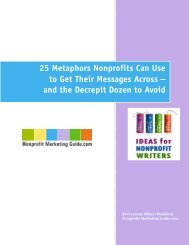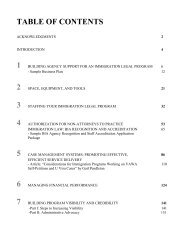Why Bad Presentations Happen to Good Causes - The Goodman ...
Why Bad Presentations Happen to Good Causes - The Goodman ...
Why Bad Presentations Happen to Good Causes - The Goodman ...
You also want an ePaper? Increase the reach of your titles
YUMPU automatically turns print PDFs into web optimized ePapers that Google loves.
David Garvin, a professor at the Harvard Business School and author of Learning<br />
in Action, asserts that learning is a three-step process. In step one, you acquire the<br />
information – in this case, by attending a presentation. In step two, you interpret the<br />
information <strong>to</strong> determine how it applies <strong>to</strong> your life or work. And in step three – which<br />
is critical but often overlooked, according <strong>to</strong> Garvin – you apply the new information,<br />
putting it <strong>to</strong> use in some way. Interactive exercises can let audience members apply<br />
what they have just been given, completing the learning process.<br />
A B<br />
1 2 3 4<br />
i<br />
Find ways <strong>to</strong> include<br />
interactive elements.<br />
<strong>The</strong> simplest form of interaction is question-and-answer, but respondents repeatedly<br />
<strong>to</strong>ld us through the survey that the traditional last-10-minutes-of-the-presentation Q&A<br />
session, while valuable, does not meet their needs. At the very least, presenters should try<br />
<strong>to</strong> check in with the audience periodically through the presentation. Several short Q&A<br />
sessions can break up the one-way flow of information, give the audience time <strong>to</strong> digest<br />
what they have just heard, and prevent some attendees from getting lost entirely.<br />
Joel Bradshaw often starts his workshops with Q&A, except he’s the one asking the<br />
questions. “What is one thing you would like <strong>to</strong> get out of this conversation,” he’ll ask the<br />
audience, “and what is one thing you are concerned about?” This helps Bradshaw adjust<br />
his presentation on the fly <strong>to</strong> meet the needs of the audience.<br />
Several veteran presenters reported showing video clips <strong>to</strong> break up lectures and get the<br />
audience talking. Max Atkinson, who coaches public speakers, will show famous world<br />
leaders making speeches and then ask the audience <strong>to</strong> analyze their technique. “However<br />
uncertain people are about their own skills, they are all brilliant as audiences,” says<br />
Atkinson, and it doesn’t take long before his audience is lustily shouting out critiques.<br />
Since Gerry Tabio believes “making lists and making choices” are critical components of<br />
creative thinking, he has his audience making lists throughout his workshop. “Within five<br />
minutes of sitting down,” he says, “people must make lists of facts about themselves and<br />
then choose three <strong>to</strong> use in introducing themselves <strong>to</strong> the person sitting next <strong>to</strong> them.”<br />
Cliff Atkinson teaches clients how <strong>to</strong> tell s<strong>to</strong>ries with PowerPoint. To open his<br />
presentations, he will invite several audience members <strong>to</strong> participate in a brief (and often<br />
funny) improvisational exercise. Using PowerPoint, Cliff will project a single image on<br />
a screen (e.g., an airplane) and begin telling a s<strong>to</strong>ry suggested by that image. After 30<br />
seconds, he’ll change the image, and the next person in line must continue the s<strong>to</strong>ry<br />
seamlessly using the new image as inspiration. And on it goes, image after image, audience<br />
member after audience member, for about five minutes. “This starts <strong>to</strong> shift how people<br />
see PowerPoint,” says Atkinson. “It gets the audience engaged and thinking creatively, and<br />
it breaks the ice for those nervous about speaking.”<br />
pg. 25<br />
“People can only learn if<br />
they do something with it.<br />
Questions are interactive,<br />
but I don’t consider them<br />
an interactive exercise. At a<br />
minimum, I have them write<br />
down something they can<br />
do with what they’ve just<br />
heard and then have them<br />
share their insight with others<br />
as inspiration.”<br />
– Kristen Grimm<br />
Spitfire Strategies


